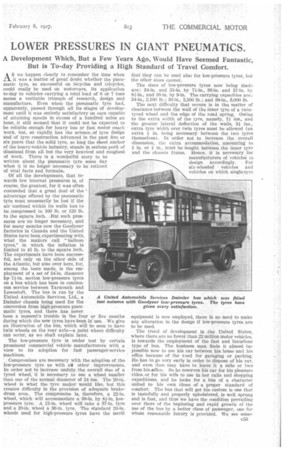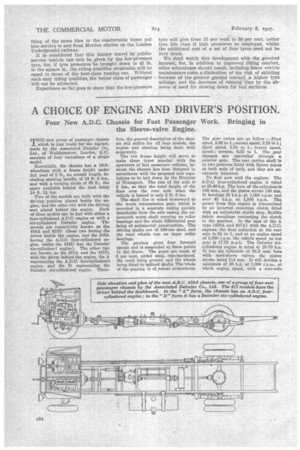LOWER PRESSURES IN GIANT PNEUMATICS.
Page 119

Page 120

If you've noticed an error in this article please click here to report it so we can fix it.
A Development Which, But a Few Years Ago, Would Have Seemed Fantastic, But is To-day Providing a High Standard of Travel Comfort.
As we happen clearly to remember the time when it was a matter of great doubt whether the pneumatic tyre, so successful on bicycles and tricycles, could really be used on motorcars, its application to-day to vehicles carrying a total load of 6 or 7 tons seems a veritable triumph of research, design and manufacture. Even when the pneumatic tyre had, apparently, passed through all its stages of development until it was entirely satisfactory on cars capable of attaining speeds in excess of a hundred miles an hour, it still seemed that it could not be expected to be reliable enough for heavy bus or fast motor coach work, but, so rapidly has the science, of tyre design and of tyre construction advanced in the past five or six pars that the solid tyre, so long the sheet anchor of the heavy-vehicle industry, stands in serious peril of dismissal from all but the very heaviest and roughest of work. There is a wonderful story to be written about the pneumatic tyre some day when it is no longer necessary to be reticent of vital facts and formula, • Of all the developments, that towards low internal pressures is, of course, the greatest, for it was often contended that a great deal of the advantage offered by the pneumatic tyre must necessarily be lost if the air confined within its walls has to be Compressed to 100 lb. or 120 lb. to the square inch. , But such pressures are no longer necessary, and for many months now the Goodyear factories in Canada and the United States have been experiinenting with what the makers call "balloon tyres," in which the inflation is limited to 45 lb. to the square inch. The experiments have been successful, not only, on the other side of the Atlantic, but also over here, for, among. the tests made, is the employment of a set of 34-in, diameter bp 7k-in. section low-pressure tyres on a bus which has been in continuous service' between Yarmouth and Lowestoft. The bus is run by the United Automobile Services, Ltd., a Daimler chassis being used for the conversion from high-,pressure pneumatic tyres, and there has .never been a moment's trouble in the four or five months during which the new tyres have been 1n use. We give an illustration of the bus, which will be seen' to have twin wheels on the rear axle—a point where difficulty can occur, as we shall explain later.
The low-pressure tyre is under test by certain prominent commercial vehicle manufacturers with a view to its adoption for fast passenger-service machines.
. Compromises are necessary with the adoption of the low-pressure tyre as with ail other , improvements. In order not to increase unduly the overall size of a tyred wheel, it is necessary to use a wheel smaller than one a the normal diameter of 24 ins. The 20-in. wheel is what the tyre maker would like, but this creates difficulty in the provision of adequate brakedrum area. The compromise is, therefore, a 22-in. wheel, which will accommodate a. 38-in. by 8i-in. lowpressure tyre. A 21-in, wheel will take a 37-in. tyre and a 20-in, wheel a 36-in. tyre. The standard 29-in. wheels used for high-pressure tyres have the merit that they can be used also for low-pressure tyres, but the other sizes cannot.
The sizes of low-pressure tyres now being Made are: 34-in. and 35-in. by 71-in., 36-in. and 37-in. by 8i-in., and 38-in. by 9-in. The carrying capacities are : 34-in„ 2,100 lb.; 36-in., 2,500 lb.; and 38-in., 3,000 lb, The next difficulty that occurs is in the matter of clearance between the wall of the inner tyre of a twintyred wheel and the edge of the road spring: OWing to the extra width of the tyre, namely, lf ins., and the greater lateral deflection of the walls, 31 ins., extra tyre width over twin tyres must be allowed (an extra in. being necessary between the twO tyres themselves). In' order not to increase the :overall dimension, the extra accommodation, amounting to ft in or ft in.. must be -sought. between the inner tyre and the chassis frame. . Hence, it is necessary. for manufacturers of .vehicles to design accordingly. . For six-wheeled vehicles and vehicle's on which single-tyre equipment is now employed, there is no need to make any alteration in the design if low-pressure tyres are to be used.
The trend of development in the United States, .where there are no fewer than 22 million motor vehicles, is towards the employment of the fast and luxurious type of bus. The business man finds it almost impossible now to use his ear between his home 'and his office because of the reed for garaging or parking. He has to go very early in order to' dispose of his car, 4nd even then may have to, leave it a mile or, two from his ,office. So he reserves his car for his pleasure rides, or, for his wife to use in. her calls and shopping expeditions, and he looks for a bus of a character suited to his own ideas of a proper standard of comfort. The bus that will get his custom is one that is tastefully and properly upholstered, is well sprung and is fast, and thus we have the condition prevailing over there of the beginning and rapid growth of the use of the bus by a better class of passenger, one for whom reasonable luxury is provided. We see some thing of the same idea in the comfortable buses put into service to and from Morden station on the London underground railway. It is considered that this luxury travel by publicservice vehicle can only be given by the low-pressure tyre, for, if tyre pressures be brought down to 45 lb. to the square in., the riding qualities obtainable will be equal to those of the best-class touring car. Without such easy riding qualities, the better class of passenger will not be attracted.
Experience so far goes to show that the low-pressure tyre will give from 15 per cent. to 30 per cent, better tyre life than if high pressures be employed, whilst the additional cost of a set of four tyres need not be very much.
We shall watch this development with the greatest Interest, for, in addition to improved riding comfort, other advantages should result, including lower vehicle maintenance costs, a diminution of the risk of skidding because of the greater ground contact, a higher tyre mileage, and the decrease of running time by the absence of need for slowing down for bad surfaces.




































































































































































































